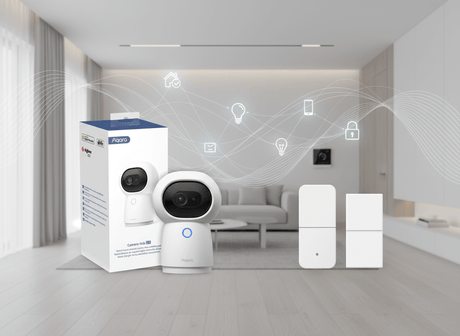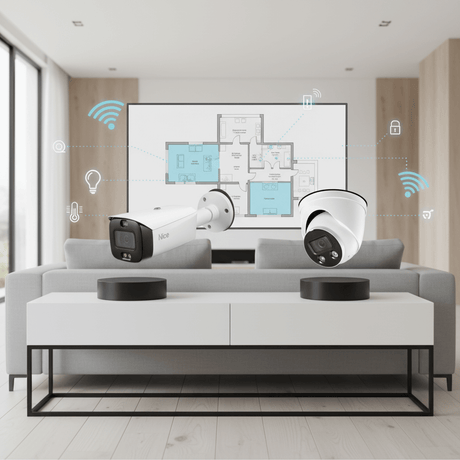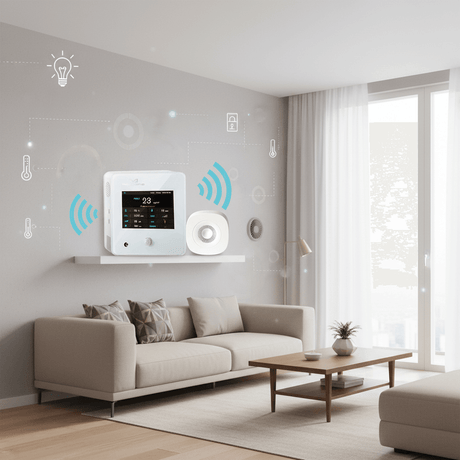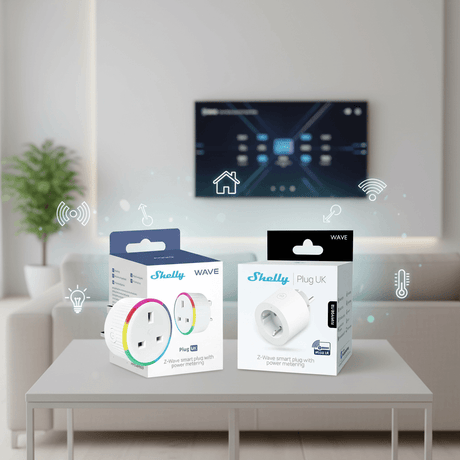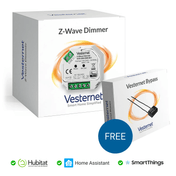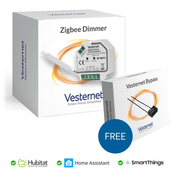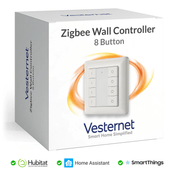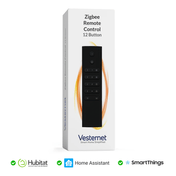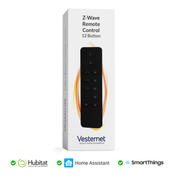Modern homes face significant fire risks, with over 35,000 house fires occurring annually in the UK alone. Traditional smoke alarms offer basic protection, but they operate in isolation, providing no alerts when you're away and no integration with emergency response systems. The evolution from standalone detectors to comprehensive monitored smoke detector systems represents a fundamental shift in home fire safety, transforming how we detect, respond to, and manage fire emergencies.
Connected fire detection systems deliver next-generation protection through real-time monitoring, instant smartphone notifications, and professional-grade sensor technology. These intelligent systems create comprehensive safety networks throughout your home, enabling automatic emergency responses and providing peace of mind whether you're at home or away. Unlike traditional alarms that rely solely on audible alerts, connected systems offer wireless connectivity, remote monitoring capabilities, and seamless integration with existing smart home automation.
This comprehensive guide explores 11 essential factors for selecting the ideal connected fire detection system for your home. From protocol compatibility and sensor technology to professional monitoring and maintenance features, you'll discover how to evaluate systems that provide superior protection whilst integrating seamlessly with your smart home infrastructure. Understanding these critical considerations ensures you make an informed decision that prioritises your family's safety and your property's protection.
1. Smart Home Protocol Compatibility for Seamless Integration
Protocol selection forms the foundation of your fire detection system's integration capabilities and long-term compatibility. Z-Wave, Zigbee, and Matter protocols each offer distinct advantages, with Z-Wave providing exceptional range and mesh networking reliability, particularly beneficial for larger properties requiring extensive coverage. Zigbee 3.0 systems excel in dense device environments, whilst Matter ensures future-proofing through universal compatibility across different smart home platforms.

Key protocol considerations:
- Z-Wave offers superior range (up to 100 metres) and strong mesh networking
- Zigbee provides excellent battery life and dense network support
- Matter ensures cross-platform compatibility and future-proofing
- Hub requirements vary significantly between protocols
Consider your existing smart home ecosystem when selecting protocols, as compatibility directly affects integration possibilities with lighting systems, security panels, and emergency automation. Professional smoke alarm installers often recommend matching your fire detection protocol to your primary smart home system to ensure seamless communication and reliable emergency responses.
2. Professional-Grade Sensor Technology and Detection Methods
Advanced photoelectric sensor technology represents the gold standard in modern fire detection, utilising light-scattering principles to identify smoke particles with exceptional accuracy. These sensors excel at detecting smoldering fires that produce minimal heat but significant smoke, providing earlier warnings compared to ionisation-based systems. Infrared detection capabilities enhance performance further, enabling systems to differentiate between genuine fire threats and common false alarm triggers like cooking smoke or steam.
Superior detection technologies:
- Photoelectric sensors detect smoldering fires up to 30 minutes faster
- Infrared capabilities distinguish between different smoke types
- Advanced microprocessors analyse patterns to reduce false alarms
- Dual-sensor combinations provide comprehensive fire type coverage
Microprocessor integration allows modern systems to learn from environmental conditions, automatically adjusting sensitivity levels to minimise nuisance alarms whilst maintaining optimal detection performance. This intelligent processing proves particularly valuable in kitchens and areas prone to steam or dust, where traditional detectors frequently trigger false alarms.
3. Multi-Functional Detection Capabilities Beyond Smoke
Contemporary fire detection systems extend beyond simple smoke sensing, incorporating temperature monitoring, heat sensors, and even PIR motion detection for comprehensive emergency protection. Temperature sensors provide critical data about rapid heat increases that may indicate flash fires, whilst heat detection capabilities ensure protection in environments where smoke detection alone proves insufficient, such as garages or workshops.

Multi-sensor advantages:
- Temperature monitoring detects rapid heat increases indicating flash fires
- Heat sensors provide protection in smoke-detector-challenging environments
- PIR motion detection can trigger emergency lighting during evacuations
- Combined sensors offer redundant protection against different fire types
PIR motion integration enables emergency lighting activation and automated escape route illumination during fire events. These multi-functional capabilities transform individual detectors into comprehensive safety hubs that respond intelligently to various emergency scenarios, providing enhanced protection that adapts to different fire characteristics and environmental conditions.
4. Wireless Communication Range and Network Reliability
Wireless range specifications directly impact system reliability, with modern monitored smoke detector systems requiring robust communication throughout multi-story homes and large properties. Mesh networking capabilities ensure signals reach every detector, creating redundant communication paths that maintain connectivity even if individual devices experience interference or temporary signal disruption.
Network reliability factors:
- Mesh networking provides redundant communication paths
- Signal repeater functionality extends coverage in large homes
- RF interference immunity ensures consistent operation
- Network topology affects overall system reliability
Range testing proves essential before finalising detector placement, particularly in properties with thick walls, metal structures, or multiple floors that may impede wireless signals. Professional fire alarm tester equipment can verify signal strength and identify potential dead zones, ensuring optimal performance throughout your entire property coverage area.
5. Power Management and Long-Term Battery Performance
Ultra-low power consumption technology enables modern fire detection systems to operate reliably for extended periods, with many systems featuring 10-year battery specifications that eliminate frequent maintenance requirements. Advanced power management algorithms monitor energy usage continuously, extending battery life whilst maintaining full functionality and ensuring consistent performance throughout the device's operational lifespan.
Battery performance features:
- 10-year battery systems reduce maintenance frequency
- Ultra-low power consumption extends operational lifespan
- Power monitoring provides advance low-battery warnings
- Sleep mode functionality conserves energy during inactive periods
Battery performance directly affects system reliability and ongoing maintenance costs. Systems with superior power management reduce the burden of regular battery replacement whilst providing consistent monitoring capabilities. Consider total ownership costs when evaluating systems, as premium batteries and efficient power management often justify higher initial investments through reduced maintenance requirements.
6. Professional Monitoring and Emergency Response Integration
Professional monitoring services transform fire detection systems from simple alarms into comprehensive emergency response networks. These services provide 24/7 monitoring capabilities, automatically contacting emergency services when fire conditions are detected, ensuring rapid response even when occupants are absent or unable to respond. Integration with security systems creates unified emergency management that coordinates fire protection with broader home security infrastructure.
Professional monitoring benefits:
- 24/7 monitoring ensures response regardless of occupancy
- Automatic emergency service notifications reduce response times
- Integration with security systems provides comprehensive protection
- Remote monitoring capabilities enable property management applications
Remote monitoring capabilities prove particularly valuable for rental properties, holiday homes, or properties requiring oversight during extended absences. Professional monitoring services often include smartphone notifications, enabling property owners to receive immediate alerts and coordinate appropriate responses based on specific emergency conditions and circumstances.
7. Installation Flexibility and Mounting Considerations
Installation flexibility significantly affects system deployment, with options ranging from hardwired 230V systems requiring professional installation to wireless battery-powered units suitable for DIY implementation. Hardwired systems provide unlimited power and often integrate directly with existing fire alarm infrastructure, whilst battery-powered units offer installation flexibility and minimal disruption during deployment.

Installation considerations:
- Hardwired systems provide unlimited power but require professional installation
- Battery-powered units enable flexible placement and DIY installation
- Ceiling mounting requirements vary between detector types
- Room-specific placement optimises detection coverage
Optimal placement varies significantly between different room types and building constructions. Professional smoke alarm installers understand specific mounting requirements for different ceiling types, room configurations, and environmental conditions. Consider professional consultation for complex installations or properties requiring extensive coverage to ensure optimal detector placement and maximum protection effectiveness.
8. Advanced Alert Systems and Visual Notifications
RGB LED indicators provide sophisticated visual notification capabilities, enabling colour-coded alerts that convey specific information about fire conditions, system status, and emergency responses. Sound level specifications ensure audible alerts reach appropriate volumes for property size and occupancy patterns, whilst multi-sensory alert capabilities accommodate different accessibility needs and emergency scenarios.
Alert system features:
- RGB LED indicators provide colour-coded status and emergency alerts
- High-decibel sound levels ensure alerts reach throughout large properties
- Visual notifications accommodate hearing-impaired occupants
- Customisable alert patterns enable system-specific identification
Multi-sensory alert systems ensure emergency notifications reach all occupants regardless of their location or accessibility needs. Visual indicators complement audible alarms, providing redundant notification methods that improve emergency awareness. These advanced alert capabilities prove particularly valuable in properties with elderly residents or accessibility considerations requiring enhanced notification systems.
9. Smart Home Automation and Emergency Response Actions
Integration with smart home automation enables sophisticated emergency response actions that extend far beyond simple alerts. Connected systems can automatically control lighting systems to illuminate escape routes, operate motorised blinds to improve visibility, unlock door locks to facilitate evacuation, and adjust HVAC controls to manage smoke spread and air quality during fire events.

Emergency automation capabilities:
- Automatic lighting activation creates clearly marked escape routes
- Motorised blind control improves visibility and emergency access
- Door lock automation facilitates rapid evacuation
- HVAC integration manages air quality and smoke containment
These automated responses prove particularly valuable during night-time emergencies when occupants may be disoriented or during situations where smoke impairs visibility and navigation. Smart home integration transforms fire detection systems into comprehensive emergency management platforms that actively assist with evacuation procedures and emergency response coordination.
10. Environmental Durability and Operating Conditions
Environmental specifications determine suitable placement locations throughout your property, with temperature operating ranges, humidity resistance, and RF interference immunity affecting performance in challenging environments. Systems designed for extended temperature ranges accommodate installation in garages, attics, and other spaces subject to temperature extremes, whilst humidity resistance enables reliable operation in bathrooms and kitchens.
Environmental durability factors:
- Extended temperature ranges enable installation in challenging locations
- Humidity resistance ensures reliable kitchen and bathroom operation
- RF interference immunity maintains performance near electronic devices
- Dust resistance prevents sensor contamination and false alarms
RF interference immunity proves crucial in modern homes filled with wireless devices, smart appliances, and electronic equipment that may disrupt communication signals. Quality fire detection systems incorporate shielding and filtering technologies that maintain reliable operation despite electromagnetic interference from household electronics and neighbouring wireless networks.
11. Maintenance Features and System Self-Diagnostics
Advanced maintenance features significantly reduce ongoing system upkeep through self-testing capabilities, tamper detection, and automatic software updates. Self-diagnostic systems continuously monitor sensor performance, communication status, and battery levels, providing proactive alerts about potential issues before they affect system reliability or emergency response capabilities.
Maintenance automation features:
- Self-testing capabilities verify sensor and communication functionality
- Tamper detection alerts identify unauthorised system modifications
- Automatic software updates maintain optimal performance and security
- Predictive maintenance alerts prevent system failures
Automatic software updates ensure systems benefit from manufacturer improvements, security patches, and enhanced functionality without requiring manual intervention. These updates often include improved detection algorithms, expanded compatibility features, and enhanced integration capabilities that maintain system relevance and performance throughout its operational lifespan.
Our Professional Fire Detection System Recommendations
Based on extensive testing and real-world performance evaluation, we've identified five exceptional connected fire detection systems that excel across different applications and requirements. The Fibaro Smoke Sensor delivers premium design excellence with advanced features in an ultra-compact form factor, making it ideal for residential applications requiring aesthetic integration without compromising sophisticated detection capabilities.
Fibaro Smoke Sensor
For professional-grade installations demanding comprehensive multi-sensor capabilities, the Heatit Z-Smoke Detector provides exceptional value through integrated PIR motion detection, emergency lighting functionality, and robust construction suitable for commercial or high-end residential applications requiring advanced emergency response coordination.
Matter Heiman Smoke Sensor
Budget-conscious users will find exceptional value in the Matter Heiman Smoke Sensor, which combines reliable 10-year battery performance with smartphone connectivity and universal Matter protocol compatibility. This system provides essential smart fire protection features at an accessible price point without sacrificing reliability or integration capabilities.
Zigbee Heiman Smoke Sensor
The Zigbee Heiman Smoke Sensor offers outstanding performance for established Zigbee 3.0 ecosystems, featuring intelligent photoelectric detection, 85dB alarm capability, and seamless integration with existing Zigbee networks. This system excels in homes with comprehensive Zigbee automation requiring reliable fire protection that integrates effortlessly with existing infrastructure.
Popp 10-Year Smoke Detector
For ultimate reliability and regulatory compliance, the Popp 10-Year Smoke Detector provides European EN14604 certification with advanced manufacturing standards and replaceable communication modules. This system offers exceptional long-term reliability and professional-grade construction suitable for applications requiring strict compliance and maximum operational dependability.
Each system excels in specific use cases: Fibaro for design-conscious installations prioritising aesthetics, Heatit for multi-functional professional applications, Matter Heiman for budget-friendly smart homes, Zigbee Heiman for established Zigbee networks, and Popp for regulatory compliance and maximum reliability. Consider your protocol preferences, budget requirements, and specific safety objectives when selecting your ideal fire detection solution.
Conclusion
Implementing a connected fire detection system transforms your home's safety infrastructure from reactive to proactive protection, delivering peace of mind through real-time monitoring, instant smartphone alerts, and intelligent integration with your broader smart home ecosystem. The comprehensive considerations explored—from protocol compatibility to professional monitoring capabilities—ensure you select a system that meets current safety requirements whilst adapting seamlessly to future smart home evolution.
Begin your fire safety upgrade by evaluating your existing smart home protocol, assessing coverage requirements throughout your property, and determining whether additional features like temperature monitoring or professional monitoring integration align with your specific safety objectives. Consider scheduling a consultation with qualified smoke alarm installers to discuss optimal placement strategies, network requirements, and integration possibilities with your current smart home infrastructure.
Explore our comprehensive smoke detection collection to discover the complete range of professional-grade systems available, and don't hesitate to contact our smart home experts for personalised guidance on selecting and configuring the ideal monitored smoke detector solution. Remember that fire safety represents an investment in your family's protection and your property's security, making thorough evaluation and professional guidance essential for optimal system performance and comprehensive emergency protection.


